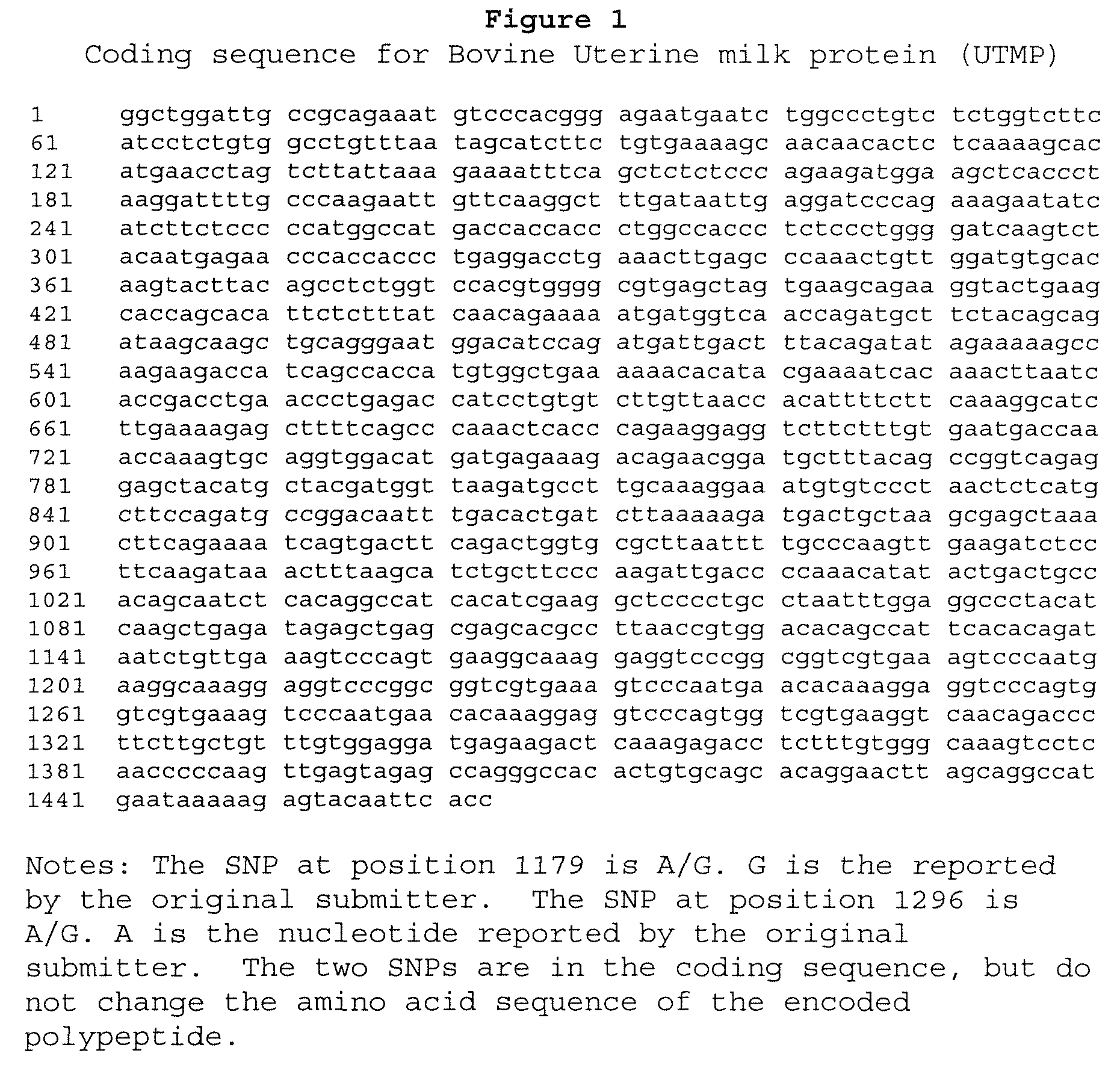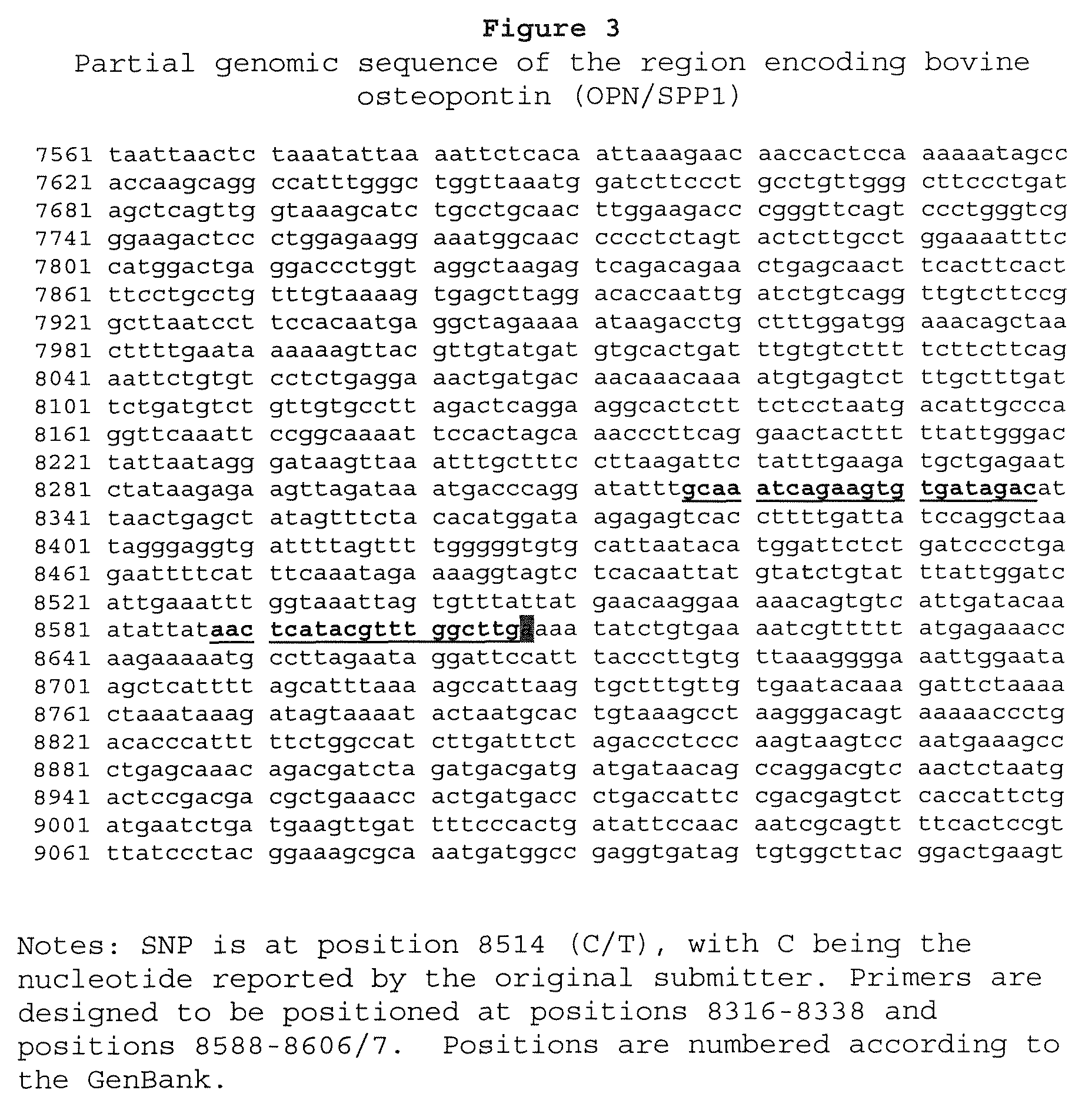Dairy cattle breeding for improved milk production traits in cattle
a technology for cattle and milk production, applied in the field of cattle progeny testing, can solve the problems that the selection based purely on phenotypic characteristics does not efficiently take into account genetic variability, and achieves the effects of increasing health/milk production life, high-quality milk production traits, and increasing milk fat yield
- Summary
- Abstract
- Description
- Claims
- Application Information
AI Technical Summary
Benefits of technology
Problems solved by technology
Method used
Image
Examples
example 1
References for Example 1
[0082]Bray, N. J., P. R. Buckland, M. J. Owen, and M. C. O'Donovan. 2003. C is acting variation in the expression of a high proportion of genes in human brain. Hum. Genet. 113:149-153.[0083]Cobanoglu, O., I. Zaitoun, Y. M. Chang, G. E. Shook, and H. Khatib. 2006. Effects of the signal transducer and activator of transcription 1 (STAT1) gene on milk production traits in Holstein dairy cattle. J. Dairy Sci. 89:4433-4437.[0084]Cowles, C. R., J. N. Hirschhorn, D. Altshuler, and E. S. Lander. 2002. Detection of regulatory variation in mouse genes. Nat. Genet. 32:432-437.[0085]Duno, M., E. Colding-Jorgensen, M. Grunnet, T. Jespersen, J. Vissing, and M. Schwartz. 2004. Difference in allelic expression of the CLCN1 gene and the possible influence on the myotonia congenita phenotype. Eur. J. Hum. Genet. 12:738-743.[0086]Guo, M., M. A. Rupe, C. Zinselmeier, J. Habben, B. A. Bowen, and O, S. Smith. 2004. Allelic variation of gene expression in maize hybrids. Plant Cell ...
example 2
References for Example 2
[0117]Akira S. (1999). Functional roles of STAT family proteins: lessons from knockout mice. Stem Cells 17, 138-46. 141[0118]Ashwell M. S., Heyen D. W., Sonstegard T. S. et al. (2004). Detection of quantitative trait loci affecting milk production, health, and reproductive traits in Holstein cattle. Journal of Dairy Science 87, 468-75.[0119]Band M. R., Larson J. H., Rebeiz M. et al. (2000). An ordered comparative map of the cattle and human genomes. Genome Research 10, 1359-68.[0120]Bole-Feysot C., Goffin V., Edery M. et al. (2005). Prolactin (PRL) and its receptor: actions, signal transduction pathways and phenotypes observed in PRL receptor knockout mice. Endocrine Reviews 19, 225-68.[0121]Boutinaud M. & Jammes H. (2004). Growth hormone increases Stat5 and Stat1 expression in lactating goat mammary gland: a specific effect compared to milking frequency. Domistic Snimal Endocrinology 27, 363-78.[0122]Darnell J. E. (1997). STATs and gene regulation. Science 2...
example 3
References for Example 3
[0145]Ashwell, M. S., D. W. Heyen, T. S. Sonstegard, C. P. Van Tassell, Y. Da, P. M. VanRaden, M. Ron, J. I. Weller, and H. A. Lewin. 2004. Detection of quantitative trait loci affecting milk production, health, and reproductive traits in Holstein cattle. J. Dairy Sci. 87:468-475.[0146]Bayless K. J., G. E. Davis, and G. A. Meininger. 1997. Isolation and biological properties of osteopontin from bovine milk. Protein Expr Purif. 9:309-314.[0147]Denhardt, D. T., M. Noda, A. W. O'Regan, D. Pavlin, and J. S. Berman. 2001. Osteopontin as a means to cope with environmental insults: regulation of inflammation, tissue remodeling, and cell survival. J Clin Invest. 107:1055-1061.[0148]Johnson G. A., R. C. Burghardt, F. W. Bazer, and T. E. Spencer. 2003. Osteopontin: roles in implantation and placentation. Biol Reprod. 69:1458-1471.[0149]Kerr J. M., L. W. Fisher, J. D. Termine, and M. F. Young. 1991. The cDNA cloning and RNA distribution of bovine osteopontin. Gene 108:2...
PUM
| Property | Measurement | Unit |
|---|---|---|
| temperature | aaaaa | aaaaa |
| volume | aaaaa | aaaaa |
| volume | aaaaa | aaaaa |
Abstract
Description
Claims
Application Information
 Login to View More
Login to View More - R&D
- Intellectual Property
- Life Sciences
- Materials
- Tech Scout
- Unparalleled Data Quality
- Higher Quality Content
- 60% Fewer Hallucinations
Browse by: Latest US Patents, China's latest patents, Technical Efficacy Thesaurus, Application Domain, Technology Topic, Popular Technical Reports.
© 2025 PatSnap. All rights reserved.Legal|Privacy policy|Modern Slavery Act Transparency Statement|Sitemap|About US| Contact US: help@patsnap.com



